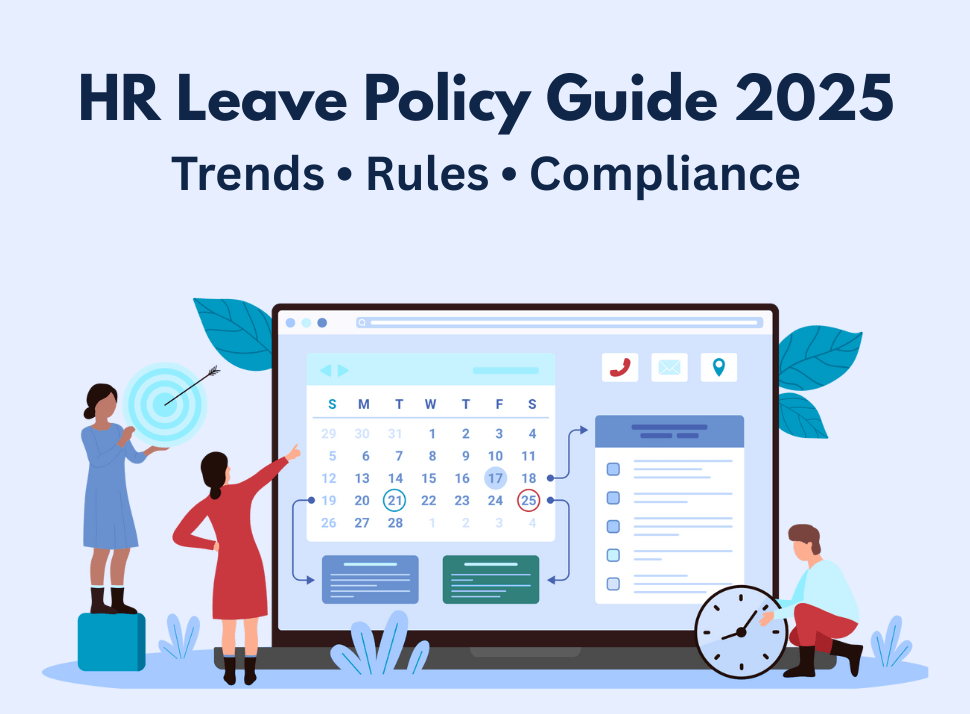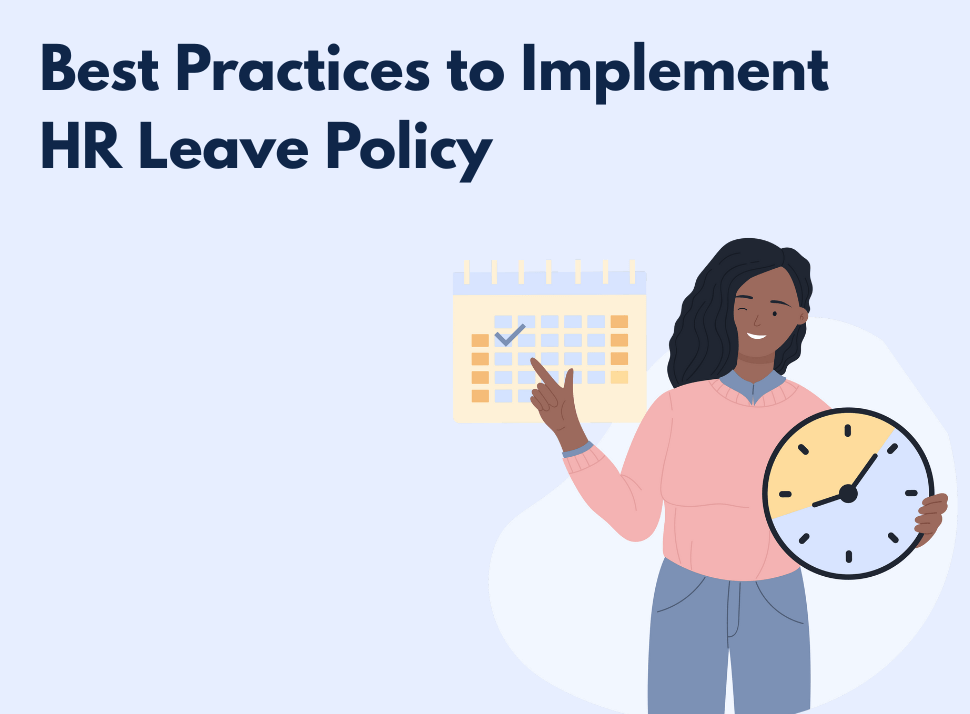In 2025, organisations will continue to understand the necessity and importance of comprehensive HR leave policies with respect to changing workforce conditions and legal requirements. An unambiguous leave policy facilitates fairness and compliance, and ensures transparency when a company has to deal with employee absences. HR teams often have to balance company requirements and employee wellness while constantly adapting to new trends (remote work and mental health initiatives) and challenges. In this guide we will outline the importance of a solid HR Leave Policy, agreements on common leave types, rights to fulfil legal obligations in India, the upward trend of key leave issues and best practices for developing a strong leave policy for today and the future.
What is an HR Leave Policy?
An HR leave policy is a formal policy that provides guidance on leave policy in an organisation. The Policy outlines all types of leave available to employees, explains how they can apply for leave and get approval, and specifies the conditions regarding where, when, and how they can take leave. A properly constructed leave policy will be helpful to both the employer and the employee, enhancing productive work environments, transparency and compliance.
Key Objectives of the HR Leave Policy
The purpose of an HR leave policy should meet the following objectives:
- Compliance: Making sure the organization meets its legal obligations regarding leave entitlements.
- Clarity: Making employees aware of their rights and responsibilities.
- Equity & Consistency: Making sure all employees are treated equitably and consistently.
- Work-life Balance: Enhancing wellbeing by helping enable employees to get enough leave.
Core Elements of an HR Leave Policy
The following are the core elements that should form an HR leave policy:
- Types of Leave: A Clear outline of the types of leave available e.g, earned leave, casual leave, sick leave, special leave.
- Eligibility: Who is able to take leave and what prerequisites are there e.g, how many days have been worked.
- Leave Request Process: What an employee has to do to take leave, e.g., notice periods, approval process etc.
- Leave Accumulation: How employees accumulate leave e.g: monthly, annually.
- Use it or lose it / carry over: Whether they can take leave into the following year or lose it.
- Leave balance: How the employer accounts and tracks employees leave balance/usage.
Types of Leaves Commonly Offered in India
Employers and employees in India need to know the different types of leave. When it comes to leave entitlements, they will vary depending on the type of organization being worked for, as well as other local factors.
1. Earned Leave (EL)
Earned Leave (EL), or Privilege Leave (PL), is the most popular leave in India. Employees earn earned leave by the employment period, usually about 12 to 30 days per year. An Earned Leave will accrue in the HR Annual Leave Policy. Earned leave can be used and carried into the next year or encash if unused.
2. Casual Leave (CL)
Casual Leave is used for unexpected short notices only. Personal emergencies or unexpected situations may warrant an employee take casual leave. Casual leave is typically non-cumulative, as it needs to be used within the same year; you cannot carry it into the next year.
3. Sick Leave (SL)
Sick leave is provided to employees who are sick and unable to undertake their duties. The number of sick days of leave depends on company policies and usually ranges from 7 to 15 days in one year. You may have to get a medical certificate for sick leave.
4. Maternity Leave (ML)
Under the Maternity Benefit (Amendment) Act, 2017, women are entitled to 26 weeks of maternity leave paid. The Maternity Leave Policy is a very important part of encouraging women to work and promoting gender equality in the workplace.
5. Paternity Leave (PL)
Paternity leave is not a requirement of Indian law but many organizations do provide male employees with 1–2 weeks of paternity leave/paid leave.
6. Special leave types
Additionally, many companies will offer special leave types including,
- Bereavement leave: Paid leave when a close family member dies.
- Marriage leave: Paid leave when the employee gets married – usually offered between 3–7 days
- Comp-off leave: Where employees work extra hours or public holidays, they can take time off as comp-off leave.
Leave Laws in India HR Teams Must Know
To ensure compliance and avoid penalties, HR leave policies in India must align with key central and state laws, such as the Factories Act and the Shops & Establishments Act. These regulations govern employee leave entitlements, including casual leave, sick leave, and earned leave. Understanding these essential laws is crucial for HR to effectively manage leave policies and stay compliant.
Overview of Central & State Leave Legislation
Both central and state leave legislation will deal with leave entitlements, and organizations must ensure they comply with the minimum statutory leave entitlements provided by these laws. The Factories Act legislates for and applies to an establishment or enterprise classified as a factory industry. The Shops & Establishments Act applies to non-factory establishments such as offices and retailers.
Factories Act versus Shops & Establishments Act
Factories Act: employees will be entitled to earned leave and various types of leave, including a minimum of 12 days of earned leave a year, as leave entitlements for workers in factories.
Shops & Establishments Act
This act entitles each member of staff to broader leave entitlement under the Act, including casual leave, sick leave, and statutory paid holidays for whichever state the business is operating in.
Essential Legal Obligations by Leave Type
- Earned Leave: Most employers grant employees 15 to 30 days of earned leave every year. Factors that influence this include industry regulations and agreements with the employer and government regulations.
- Casual Leave: Employers often have hours defined as casual leave, which would be taken in a calendar year. Employees may expect 7-12 days (or more) of casual leave in a calendar year.
- Sick Leave: Employers typically grant 7 to 15 days of paid sick leave each year (or more). If the employer requests a medical certificate, the employee must provide one.
- Maternity Leave: Under the Maternity Benefit Act, female employees may be granted 26 weeks of paid maternity leave.
Penalties for Non-Compliance
Organizations can face penalties, fines, and even legal actions if they do not abide by the regulations of either the central or state governments as they relate to leave policies. HR teams need to ensure that they continually review their policies to ensure compliance to protect the organization from potential legalities.
Top HR Leave Policy Trends in 2025
As we continue our journey through 2025, both HR leave policies and the current trends surrounding them will undoubtedly change. Here are some current trends to watch for:
1. Mental Health Leave & Well-Being
Organizations are concentrating their efforts on the mental health of employees. In 2025, many organizations will include mental health leave in the form of paid time-off to help employees with stress, anxiety and other mental health needs. Organizations are trying to create more understanding work environments and make mental health a bigger priority.
2. Gender-Neutral and DEI-Inclusive leave policies
In 2025, Gender-neutral leave policies will be a trend and many companies will have inclusive leave policies that are gender-neutral and available to all employees regardless of their gender identity. Gender-neutral leave policies really come from the long work to enhance diversity, equity, and inclusion (DEI) and will allow all employees the same access to leave.
3. Remote & Hybrid Work Leave Flexibility
With remote and hybrid work options on the rise in organizations, businesses are re-evaluating their leave policies to provide flexibility for employees outside the office. Organizations may offer more flexible leave programs, such as unlimited paid time off or flexible leave options that support different employee needs.
4. Unlimited and PTO Models Emerging in India
Indian organizations are now beginning to experiment with unlimited paid time off (PTO), following the global trend. It is beginning to allow employees the opportunity to enjoy time off as needed (as long as their work is done). This model is still in development in India however is likely to catch on, especially in the tech sector and startup scene.
How to Design a Compliant HR Leave Policy
In order to develop a legally compliant HR leave policy that furthers business aims, organizations should take their time in undertaking their process. Below are important steps for organizations as they begin this process:
1. Mapping Business Needs through Legal Obligations
While you leave policy must include the minimum legal obligations, employers should still account for their specific leave needs. This may look like allowing customized overall leave entitlements, subsequent to the minimum legal obligations, depending on your business operations or the preferences of the employees.
2. Mapping Practices with Company Culture & Workforce Expectations
The leave policy developed by your organization should represent your company’s values. Similarly, if your company states that it promotes work-life balance and well-being of employees, you should consider additional leave options (e.g. wellness leave, mental health leave, etc.).
3. Mapping Inclusivity & Fair Treatment within Policy Development
A useful component of HR leave policies is that they can ensure equal treatment of all employees. Consider including practices in your policies to take into consideration a variety of employee needs (e.g. provide gender-neutral parental leave, or adopt any accommodation requested by an employee with a disability to take advantage of leave opportunities).
Best Practices for HR Leave Policy Implementation
A leave policy is only effective when employers clearly communicate it and actively track and review it. The following must-dos can help serve as best practices:
1. Communicating Policy to Employees
Immediately make your employees aware of the HR leave policies in India. Make policy documents clearly available and try to communicate policy changes frequently.
2. Leverage HR Tech for Leave Tracking & Automation
Make use of HR technology to automate the process of leave tracking. Automated systems can significantly help lessen administration work while also reducing mistakes with real-time leave request processing and tracking, leave approvals and leave balances.
3. Periodically Review Policies and Establish Feedback Loops
Regularly review your HR leave policies to update them with human capital and legislative changes. Provide feedback opportunities for employees that may identify ways to improve the effectiveness of the leave policy.
4. Ensuring Leave Policy is Enforced Fairly to Prevent Misuse
Managers must consistently enforce the leave policy across the organization. The policy should clearly define the process for monitoring and approving requests to prevent misuse or abuse
Final Thoughts
With the ever-changing nature of work, leave policies have a responsibility to reflect the needs of a diverse workforce. Organizations can develop leave policies that comply with labor law and workplace best practices, while also creating positive pathways for employees by keeping relevant trends in mind, including staying current with the law and best practices.


